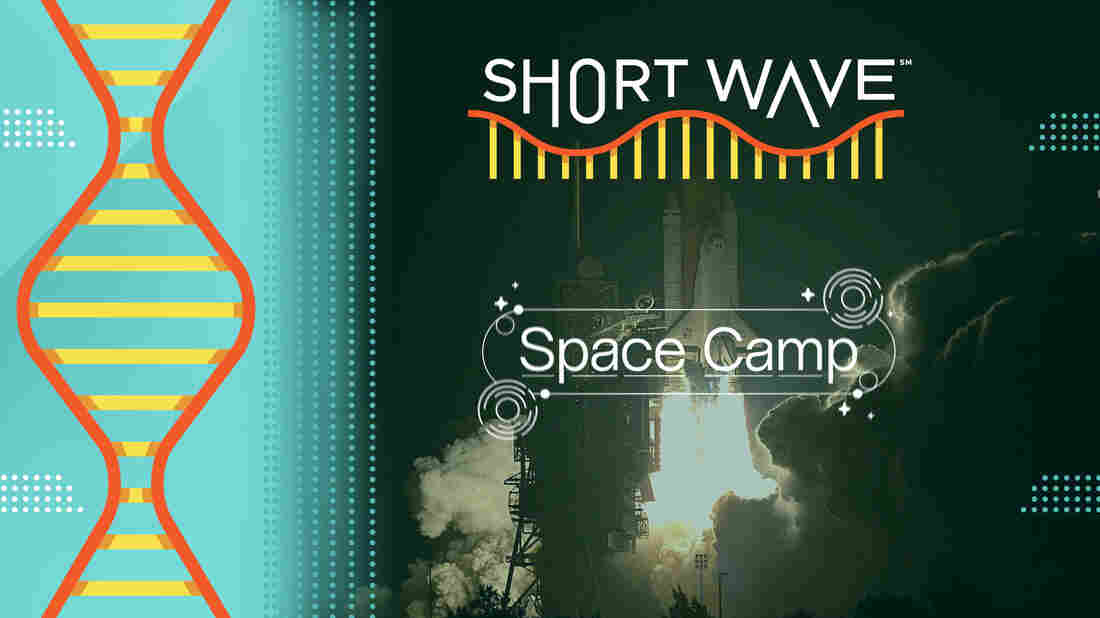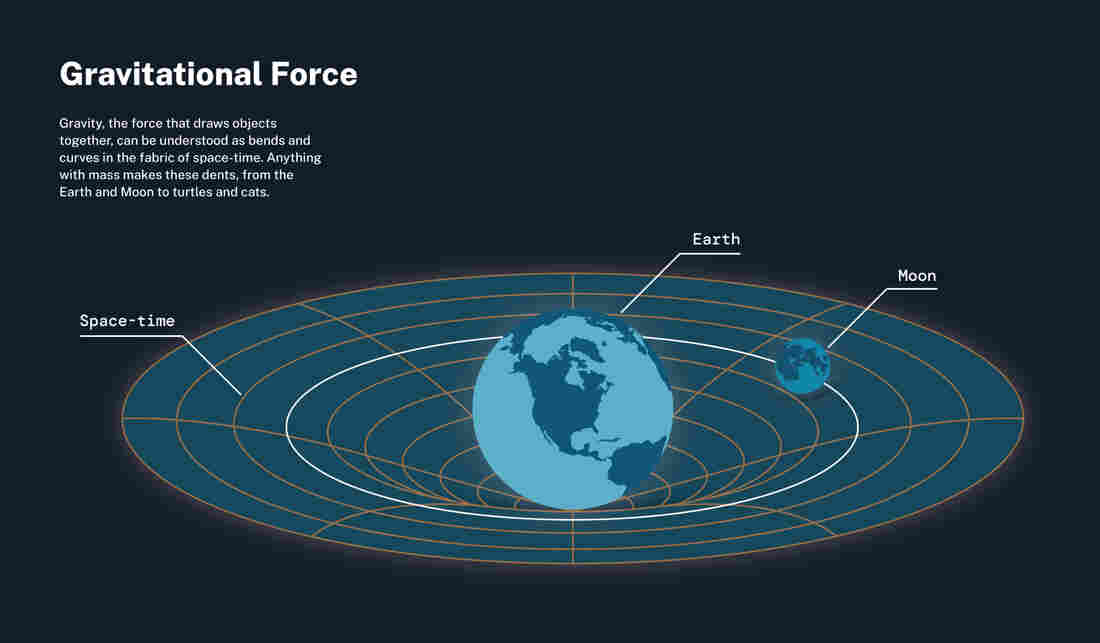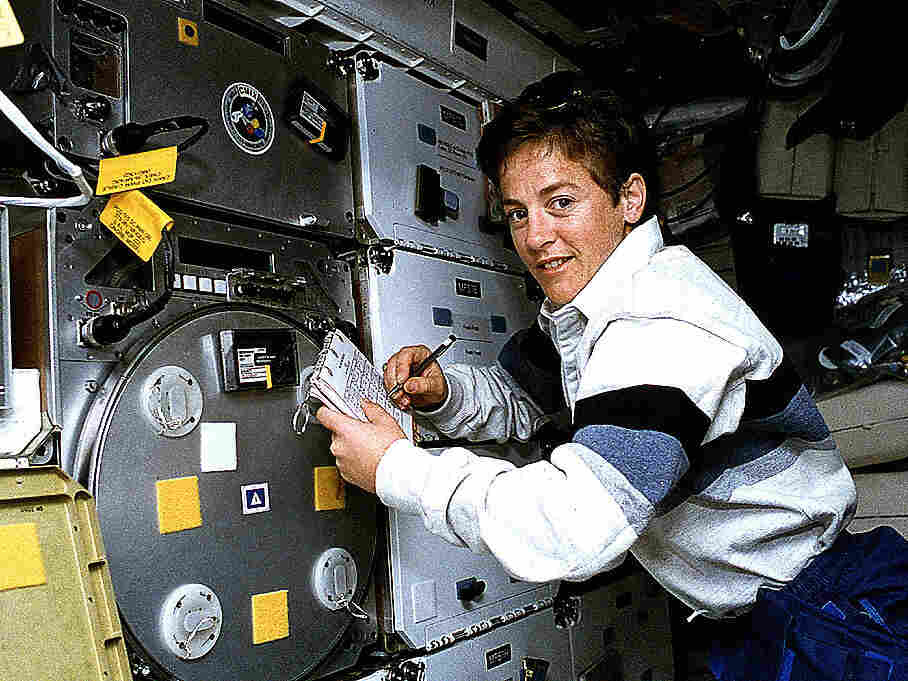
Astronaut Wendy B. Lawrence was aboard Space Shuttle Endeavor for mission STS-67/ASTRO-2 when it launched on March 2, 1995.
NASA
hide caption
toggle caption
NASA

Astronaut Wendy B. Lawrence was aboard Space Shuttle Endeavor for mission STS-67/ASTRO-2 when it launched on March 2, 1995.
NASA
What does it take to launch into space?
Besides money, hard work, and many moving parts, the answer is science! This summer, the NPR science podcast Short Wave is launching Space Camp, a series about all the weird and wonderful things in our universe. We start by knowing how to get to space.
Rockets and Isaac Newton
It goes without saying, but in order for a person to get to space, they need to be in some sort of spaceship attached to a rocket.
This rocket launches exhaust gases as it leaves the launch pad. This exhaust heads towards the launch pad. This is where Isaac Newton’s third law of motion comes into play. This law says that “for every action there is an equal and opposite reaction.” So when the exhaust pushes down, it creates an upward force, allowing the rocket to rise skyward.
Here, former MIT professor Walter Lewin completes a joint proof of Newton’s third law of motion, as part of his farewell lecture.
Newton’s Third Law – Best Demonstration EVER!! – by Professor Walter Lewin
Youtube
A good example on a smaller scale is a common physics demonstration where someone is holding a fire extinguisher while sitting on a wheeled object. Like in this video, when the fire extinguisher goes off, the person goes in the opposite direction.
Exhaust from a rocket launched into space does the same thing.
The rocket must go very fast because it must overcome the curvature of space-time itself. The fabric of our universe, called space-time, can be thought of as a foldable sheet. The mass of the Earth causes the flat fabric of space-time to curve inward into a funnel shape. Going up the funnel – thus escaping Earth’s gravity – is more difficult than going down.

This illustration explains gravitational force, also known as “g-force.” It is one of the four fundamental forces of the universe and is seen bending space-time amid the mass of the Earth.
NASA
hide caption
toggle caption
NASA

This illustration explains gravitational force, also known as “g-force.” It is one of the four fundamental forces of the universe and is seen bending space-time amid the mass of the Earth.
NASA
G forces and why flutter decreases
When these rockets take off, astronauts experience intense g-forces.
G forces come from when your body experiences acceleration. When you sit or walk around on Earth, you probably don’t notice them, even though there is still the regular pull of Earth’s gravity, which is 1 G.
You’re most likely to notice them when you’re doing something like getting into an elevator fairly quickly. Then you feel heavier.
But the heaviness of being in a fast elevator is nothing compared to what astronauts feel during a launch. Wendy Lawrence, a retired Navy captain and former NASA astronaut, recalled the sensation of intense g-forces she felt to NPR in a recent interview.
“I remember on my first flight I thought, ‘Oh my God, someone just sat on my chest,'” she says. “I tried to see if I could put my arm in front of me…and I thought, ‘Wow, I can’t resist this enormous power and acceleration produced by this incredible space vehicle.'”

Astronaut Wendy B. Lawrence, flight engineer and mission specialist for STS-67, scribbles notes on the margins of a checklist while monitoring an experiment on the middeck of the Space Shuttle Endeavour.
MSFC/NASA
hide caption
toggle caption
MSFC/NASA

Astronaut Wendy B. Lawrence, flight engineer and mission specialist for STS-67, scribbles notes on the margins of a checklist while monitoring an experiment on the middeck of the Space Shuttle Endeavour.
MSFC/NASA
Very quickly, this experience changes. Once the rockets detach from the spacecraft, the force pushing the astronauts toward their seats disappears. They start to float under their seat belts.
They feel what is commonly called weightlessness.
But the gravity has not disappeared. Even on the International Space Station, astronauts experience microgravity.
You can get a little taste of that feeling on Earth. There are rides at amusement parks that soar, making riders feel heavy, and then drop them. During this fall, riders feel weightless even though they are falling. In physics this is called free fall. Technically, all astronauts on the International Space Station fall very slowly, which is why they feel weightless.
Captain Lawrence says it’s an incredible experience. “Relax,” she recalls. “You’re hanging there, in the middle of the air, and you want to park in front of a window and float in front of it and watch the world go by.”
To orbit is to fall and miss Earth
It turns out that going into orbit, as astronauts do aboard the International Space Station, is declining. More precisely, it is towards Earth.
Newton had a series of thought experiments to explain this idea.
Scenario 1: Imagine that you are standing on flat ground. Now imagine that you are firing a cannonball horizontally from your position on the ground. In this scenario, the cannonball will move horizontally for a period of time before starting to fall along a curved path. It’s a projectile movement.
Scenario 2: You fire that same cannonball horizontally – from the top of a very tall mountain. In this case, the ball would hit the ground even further because it would have had to fall further and would have stayed in the air longer. If you fire the cannonball at a higher speed, it will move even further. This curved path becomes more and more stretched.
Scenario 3: With a high enough launch speed, you can make the cannonball fall in a curved path that matches the curvature of the Earth. Since the curvatures match, the cannonball continues to miss the Earth. This is what it means to have something in orbit. The cannonball falls but never reaches the ground.
Preview of Next Week’s Shortwave Space Camp: Pluto
Now, if we move out of Earth’s orbit and get to the end of our solar system, we will overtake Pluto, the beloved ancient planet. Next week we will ask ourselves: why are there only 8 planets in our solar system? What does it mean that Pluto was demoted to a dwarf planet all those years ago? We also explain why Pluto’s geology surprised scientists.
Do you have any other space stories you’d like us to cover? Send us an email at shortwaves@npr.org.
Listen to Short Wave on Spotify, Apple Podcasts And Google Podcasts.
Listen to every episode of Short Wave without a sponsor and support our work at NPR by subscribing to Short Wave+ at plus.npr.org/shortwave.
This episode was produced by Berly McCoy, edited by Rebecca Ramirez and fact-checked by Regina Barber, Emily Kwong and Rebecca. Gilly Moon was the sound engineer.